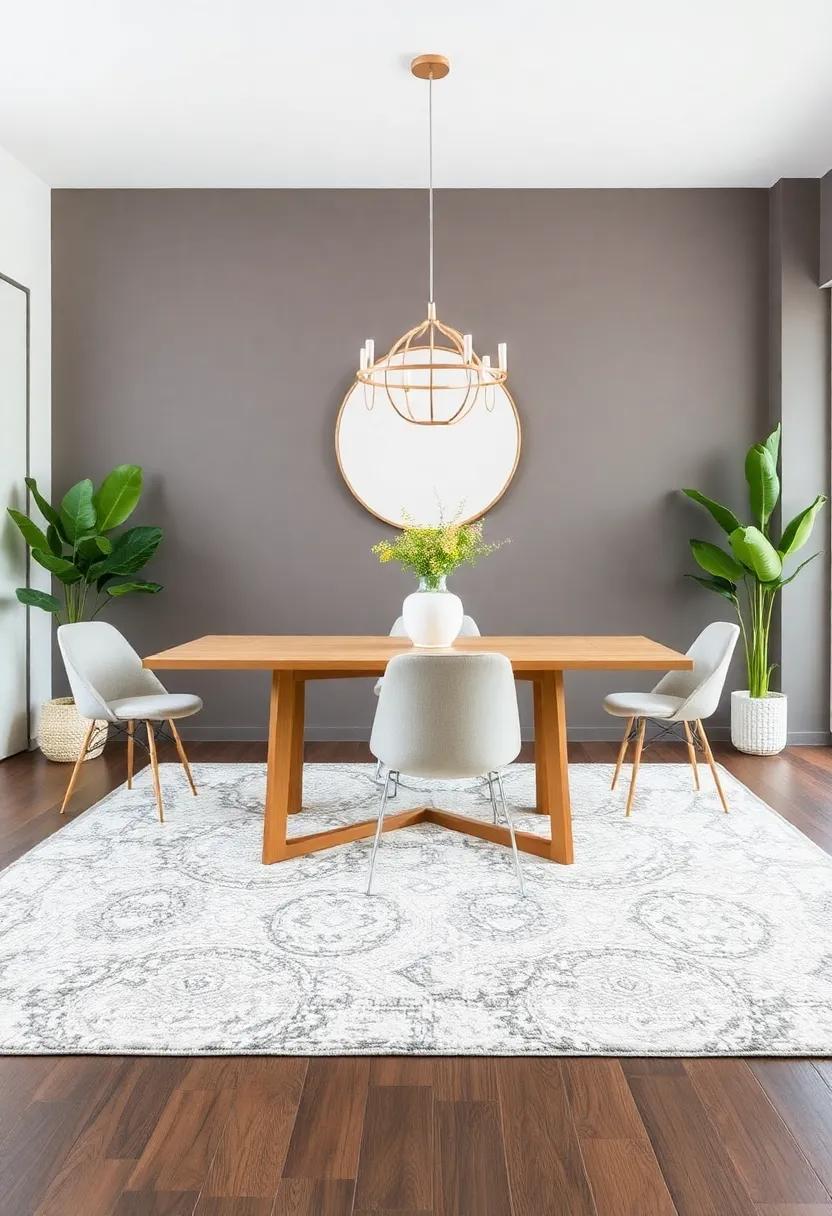A dining space is more than just a place too enjoy a meal; it is a canvas where memories are painted, conversations flow, and laughter echoes.The right elements come together to create an inviting atmosphere, and one often overlooked aspect is the rug beneath your feet. A thoughtfully chosen rug can not only define the dining area but also enhance its style and comfort, transforming an ordinary setting into an unusual experience. In this guide,we will explore how to select the perfect rug that balances design with practicality,ensuring your dining space is both aesthetically pleasing and cozy. Whether you seek a vibrant statement piece or a subtle complement to your existing decor, discovering the ideal rug will elevate the ambiance of your dining area, making every meal feel special. Join us as we delve into the world of textures, colors, and patterns that can harmoniously align to create a dining sanctuary you’ll cherish for years to come.
Selecting the Right material For Your Dining Rug To Enhance comfort And Aesthetic Appeal
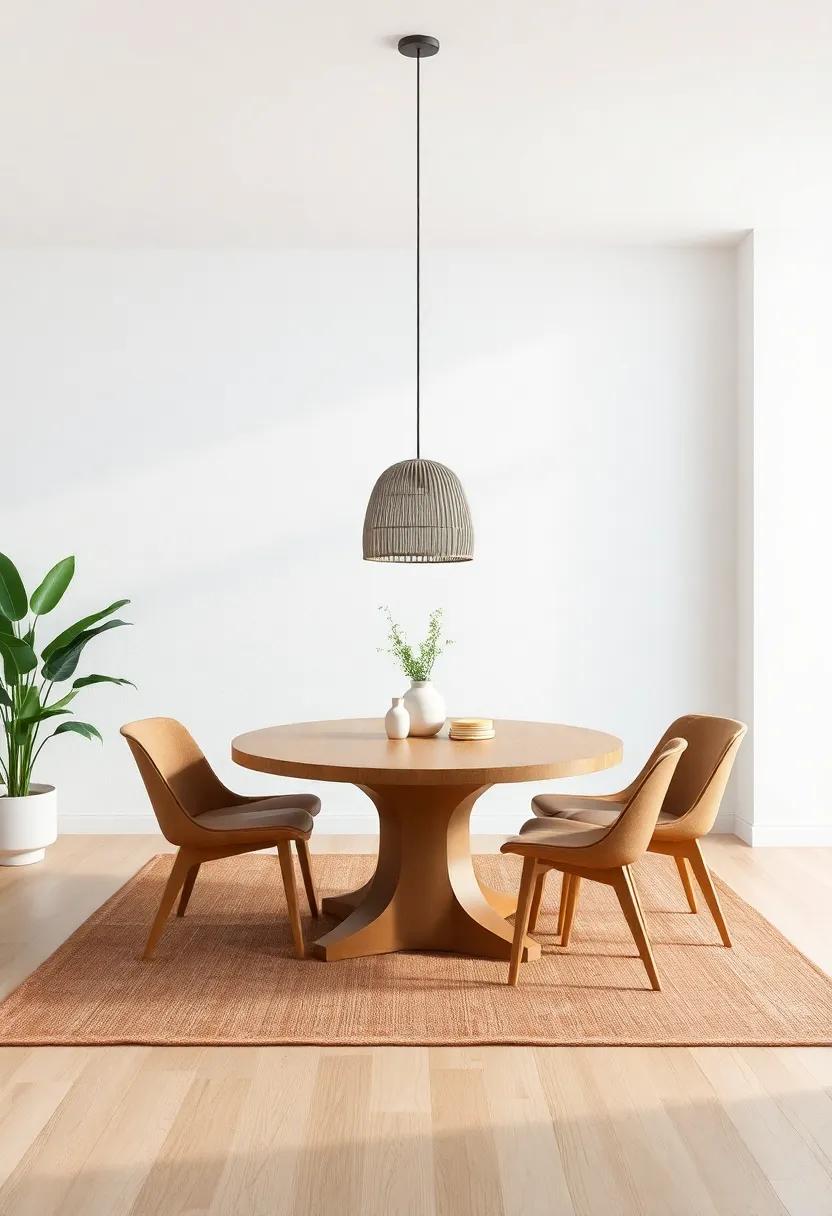
When selecting a rug for your dining area, it’s essential to consider both comfort and aesthetic appeal. The material you choose will considerably impact the overall look and feel of the space. Common materials include wool, synthetic fibers, and natural fibers such as jute or sisal, each offering unique benefits. Wool is known for its durability and softness, making it a luxurious choice that can withstand daily use.synthetic fibers, like nylon and polypropylene, are budget-pleasant and typically stain-resistant, perfect for families with young children or pets. On the other hand, natural fibers bring a warm, organic feel to your dining area, but they might require more maintenance.
Besides material, the rug’s texture and pile height should also be taken into account to enhance comfort. Consider thes options:
- Low-pile rugs for easy cleaning and a sleek look.
- Medium-pile rugs that offer a balance of softness and durability.
- high-pile rugs for plush comfort, although they may be more challenging to maintain.
Additionally, color and pattern can tie the dining space together. A vibrant, patterned rug can serve as a focal point, while a solid or muted rug allows your furniture and decor to shine. Ensure that the style of the rug complements your dining furniture, creating a cohesive design that invites both comfort and conversation.
Finding the Ideal Size For Your Rug To Balance Your Dining Space Perfectly

Choosing the right size rug for your dining area can significantly enhance the overall ambiance of the space. A well-sized rug acts as an anchor, visually tying together your dining set while adding warmth and texture. To achieve the perfect balance, consider the following guidelines when measuring:
- Ensure Clearance: Ideally, the rug should extend at least 24 inches beyond the edges of the dining table. This allows chairs to slide in and out easily.
- Table Size Matters: For a standard table, a rug measuring 8×10 feet is frequently enough a safe choice, but larger tables may require larger rugs to maintain proportion.
- Room Dimensions: Always keep in mind the overall size of your dining room. A rug that is too small can make the space feel disjointed.
To further simplify your decision, here’s a helpful reference table that outlines common rug sizes suitable for various dining table shapes:
| Table Shape | recommended Rug Size |
|---|---|
| Round | 6×6 feet |
| Rectangular | 8×10 feet |
| Square | 8×8 feet |
| Long Rectangle | 9×12 feet |
Following these size recommendations will help ensure that your dining space is not only beautiful but also functional. A thoughtfully chosen rug can elevate your room’s aesthetics while providing comfort and cohesion, making every meal a delightful experience.
Exploring Color Palettes That Complement Your Dining Room Décor

choosing a rug that complements your dining room decor is an possibility to play with color palettes that elevate the overall ambiance. Consider a neutral base for your rug, allowing for larger statement pieces in the room to shine without overwhelming the eye. Alternatively, opt for a bold pattern that reflects the vibrancy of your dining table or chairs. This can serve as a conversation starter,bringing together hues from various elements of the room. Think about incorporating colors like:
- Warm earth tones – such as terracotta or muted greens, which create a cozy, inviting space.
- Cool blues and grays - to promote tranquility and sophistication, complementing more modern decor.
- Rich jewel tones – like deep burgundy or sapphire, which can add depth and drama to your dining area.
To further refine your color selections, consider how different shades interact with your existing decor. Using a color wheel can definitely help in finding complementary or analogous shades that bring harmony to your dining room.Below is a useful reference table that pairs common dining room colors with complementary rug colors:
| Wall Color | Complementary Rug Color |
|---|---|
| Light Gray | Charcoal or Slate Blue |
| Warm Beige | Deep Olive or Rust |
| Cool Blue | Ivory or soft Yellow |
Creating A Cohesive Look With Patterns That Bring Life To Your Dining Area
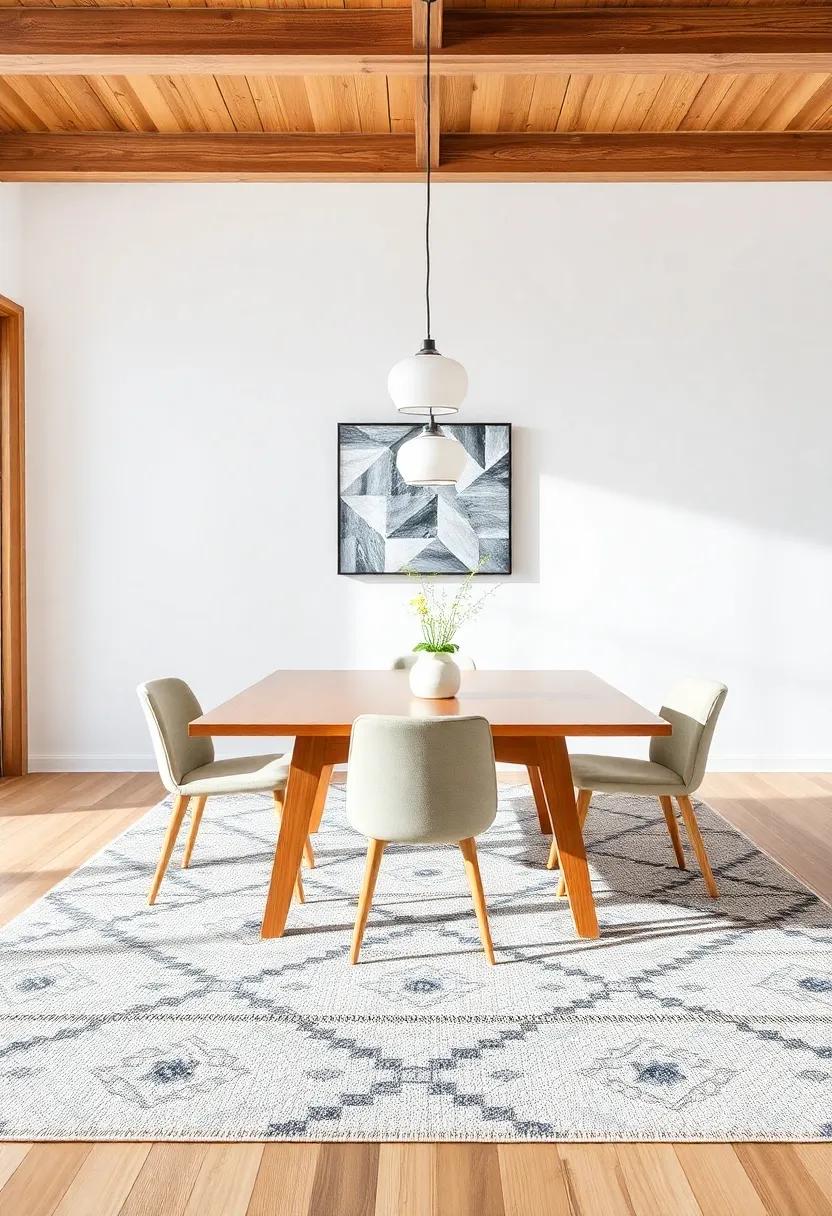
Incorporating patterns into your dining area can transform it from ordinary to extraordinary. When selecting a rug, consider how the geometry, colors, and textures interact with your existing decor. patterns can unify disparate elements in the space, creating a cohesive look that invites warmth and liveliness. Opt for graphic designs that play with shapes, or choose florals for a more organic touch. Look for rug patterns that reflect the mood you wish to cultivate, whether that’s casual and inviting or elegant and refined.
as you curate your dining area’s aesthetic, pay attention to the scale of your patterns.A balanced mix of large and small prints can help avoid overwhelming the space. Here are some tips for a harmonious combination:
- <strong.Pair Awkwardly: Combine a large patterned rug with smaller dishware prints.
- <strong.Color Connection: Use a color palette that resonates throughout the room to tie various patterns together.
- <strong.Layering: layer rugs with complementary patterns for added depth.
Choosing Between Indoor And Outdoor Rugs for Versatile Dining experiences

When creating a dining space that balances aesthetics and functionality, the choice between indoor and outdoor rugs plays a pivotal role. Indoor rugs frequently enough encapsulate warmth and luxury, making them ideal for formal dining settings. They can feature intricate patterns and textures that enhance the elegance of your décor.Conversely, outdoor rugs are designed for durability and weather resistance, suitable for alfresco dining experiences. They frequently enough come in vibrant colors and designs, easily blending into a casual or bohemian atmosphere. Consider the following factors when deciding:
- Climate and Surroundings: An outdoor rug can withstand changes in weather and is easy to clean.
- Foot Traffic: High-traffic dining areas may benefit from the sturdiness of outdoor rugs.
- Style Preferences: The right rug can either complement or contrast your dining furniture.
To further simplify your decision-making process, here’s a comparison table to highlight key features between the two types of rugs:
| Feature | indoor Rugs | Outdoor Rugs |
|---|---|---|
| Material Variety | soft fibers (wool, cotton) | Durable synthetic materials |
| Maintenance | Regular vacuuming, professional cleaning | Machine washable or hose-off |
| Comfort Level | High level of coziness | Typically less soft, but functional |
| Pattern Range | Variety of intricate designs | Shining, bold patterns |
Understanding The Role Of Texture In Rug Selection For A warm Atmosphere
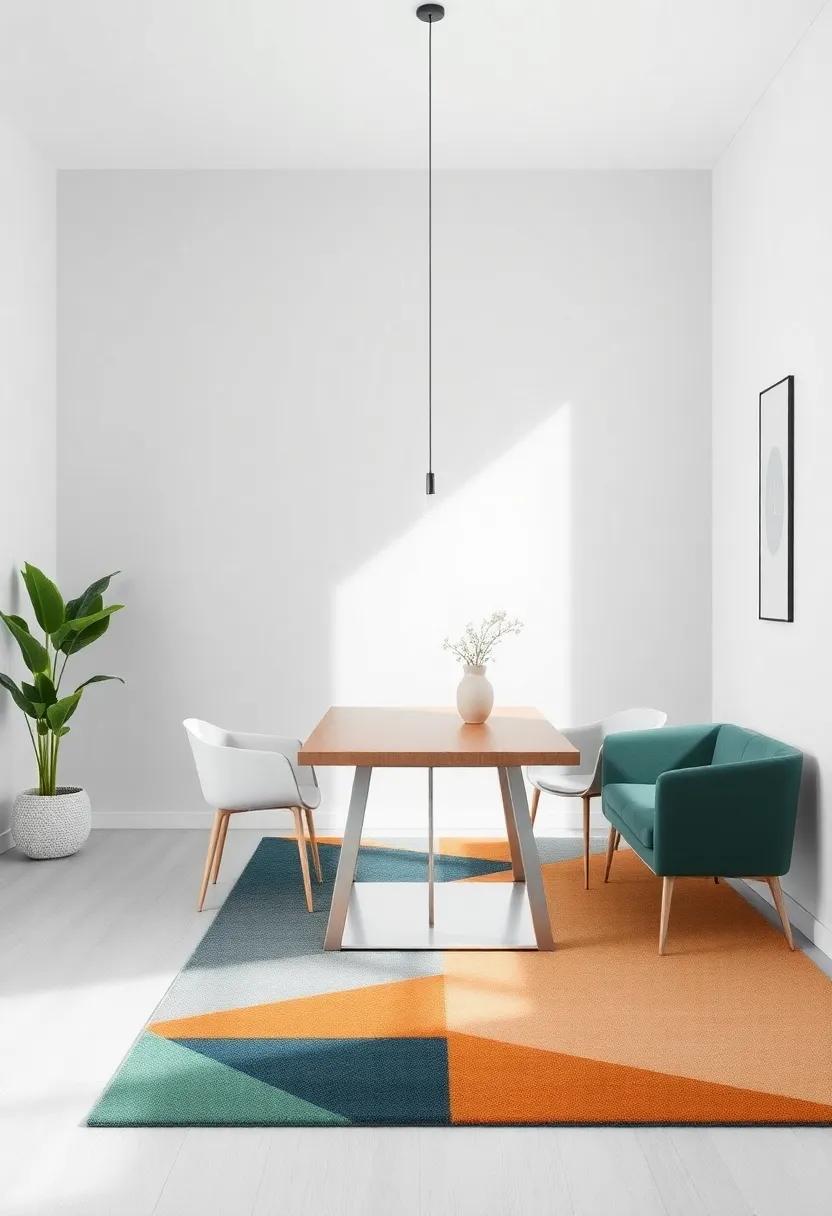
When selecting a rug for your dining space, texture plays a pivotal role in creating an inviting atmosphere. The tactile experience of a rug can evoke warmth and comfort, enhancing the overall dining experience. Consider how different textures interact with your existing decor and the emotional response they elicit.For instance, plush shag rugs can add a sense of coziness and relaxation, while flatweave options provide a sleek, modern look that still feels welcoming. Exploring materials such as natural fibers, like jute or wool, can infuse warmth into the room, making it feel more intimate and connected.
To complement your chosen texture, it’s essential to think about the color palette and patterns that align with the desired ambiance. A soft, muted texture in earth tones can create a serene backdrop for lively dining moments, while a bold, geometric pattern can stimulate conversation and create a dynamic focal point. Here are a few key considerations to keep in mind:
- Contrast: Mix textures for visual interest; pair a soft rug with sleek furniture.
- Maintenance: Choose textures that are easy to clean, especially in dining areas prone to spills.
- Comfort: Ensure that the rug feels good underfoot, enhancing the overall comfort of your dining environment.
Incorporating Eco-Friendly Rugs To Embrace Sustainable Dining Style

Embracing eco-friendly rugs in your dining space not only elevates style but significantly contributes to sustainability efforts. Choosing rugs made from natural fibers, such as jute, sisal, or organic cotton, can create a warm and inviting atmosphere while reducing your environmental footprint. These materials are biodegradable and often produced through sustainable practices, which means your choice can support ethical industries. When paired with your dining furniture, these rugs add texture and depth, enhancing the overall ambiance of the room.
Here are some benefits of incorporating eco-friendly rugs:
- Durability: Natural fibers frequently enough have a longer lifespan, making them a cost-effective choice.
- Hypoallergenic: They are less likely to contain harmful chemicals, promoting better indoor air quality.
- Versatility: Available in a variety of designs and colors, they can complement various dining styles.
To help visualize your options, consider the following table of popular eco-friendly rug materials:
| Material | Characteristics |
|---|---|
| Jute | Strong, affordable, and biodegradable. |
| Sisal | Highly durable and resistant to stains. |
| Organic Cotton | Soft, breathable, and made without pesticides. |
Highlighting The Benefits of Different Weave Types For Dining Room Rugs

when selecting a dining room rug,the type of weave can significantly influence both aesthetics and functionality.Hand-knotted rugs exude luxury and craftsmanship, with each piece featuring unique designs that tell a story. Their durable construction ensures they withstand the wear and tear of a bustling dining area, making them a worthwhile investment. Flatweave rugs, on the other hand, boast a sleek profile, perfect for contemporary spaces. They are easy to clean and can be easily repositioned, offering versatility for rearranging your dining setup.
Additionally, tufted rugs provide a plush feeling underfoot, inviting comfort during long family dinners or gatherings. The variety of patterns available in tufted designs allows for personalization, catering to individual tastes and décor themes. For those seeking low-maintenance options, natural fiber rugs made from jute or sisal bring eco-friendly charm to your dining space. They are resilient to spills and easy to clean while adding texture to the room. With so many weave types to consider, it’s essential to choose one that aligns with your lifestyle and the overall design of your home.
Exploring seasonal Rug Options To Refresh Your Dining Area Throughout The Year
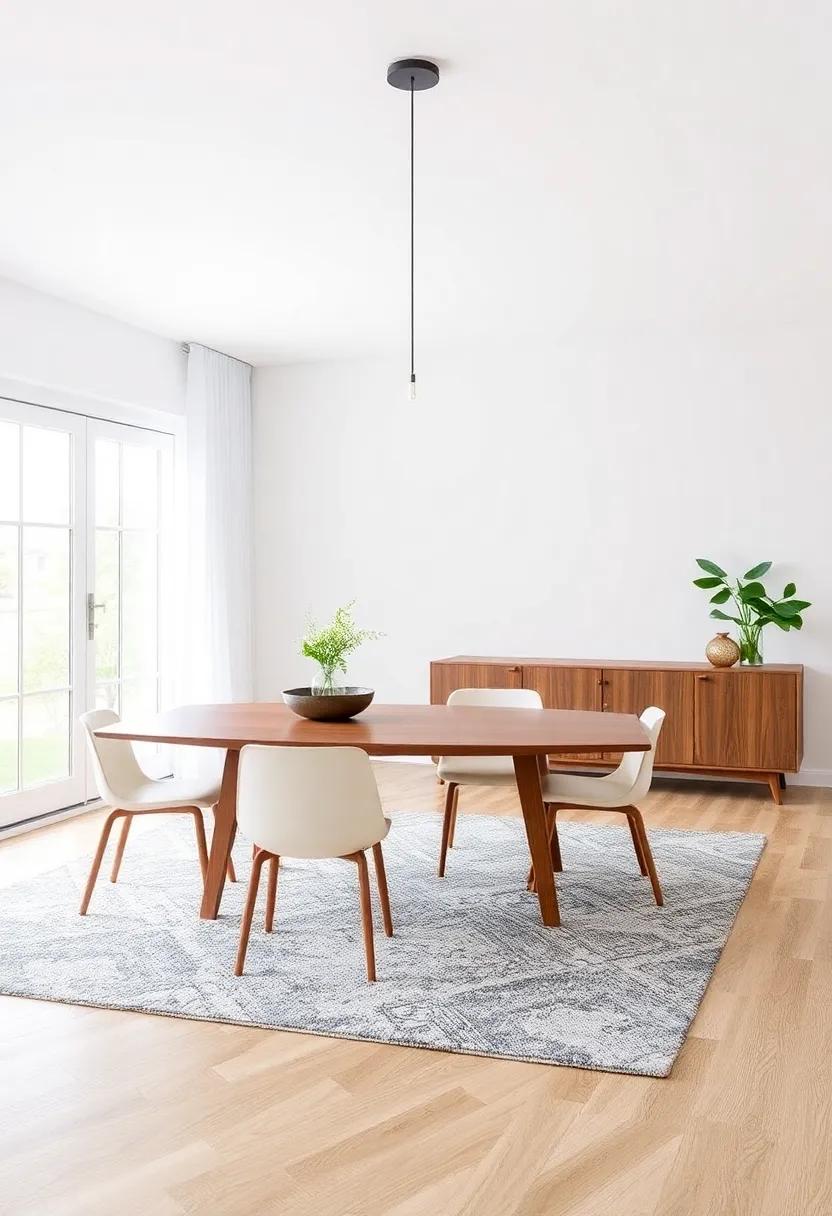
As the seasons shift, so too can the tones and textures of your dining area. Consider incorporating a warm,rich-toned rug in the fall to complement the changing leaves and cozy gatherings. Rugs made from natural fibers, such as wool, bring both comfort and durability, perfect for entertaining friends and family around the table. Opt for earthy colors like burnt orange, deep red, or mustard yellow to create a welcoming atmosphere that reflects the essence of autumn.
Spring invites a different palette, where lightness and freshness reign. A vibrant floral or playful geometric rug can breathe new life into your dining space, mirroring the blossoming flowers outside. Choose materials that are easy to clean, allowing for seamless transitions from outdoor barbecues to indoor dining. Consider alternatives like cotton or synthetic blends which can handle spills and foot traffic while keeping your decor lively.With these thoughtful selections, your dining area will feel energized and inviting year-round.
Enhancing Your Dining Space with Statement Rugs That Make A Lasting impression

When it comes to transforming your dining space, statement rugs serve as not just functional pieces, but as pivotal elements that can redefine the entire atmosphere. They help to anchor the room, provide warmth underfoot, and add a layer of textile richness that complements your decor. Consider rugs with bold patterns or vibrant colors that harmonize with the dining room palette while still standing out. Some inspiring options include:
- Geometric Patterns: Modern and chic, these styles can infuse an artsy edge.
- Floral Designs: Perfect for a more traditional or rustic dining aesthetic.
- Textured weaves: Rugs with varied textures offer depth and tactile interest.
To select the ideal size, ensure that your rug either encompasses the dining table or extends beyond it to allow chairs to slide comfortably. The placement is equally essential; a well-placed rug can delineate the dining area from the surrounding spaces, enhancing the sense of coziness and structure. Incorporating a table that reflects or contrasts with the rug’s pattern can create a dynamic conversation piece. Here’s a rapid reference:
| Rug size | Recommended Table Size | Chair Clearance |
|---|---|---|
| 5′ x 8′ | up to 4 seats | 24″ minimum |
| 8′ x 10′ | 6 seats | 30″ minimum |
| 9′ x 12′ | 8 seats | 36″ minimum |
Combining Rugs With Furniture Styles For A Harmonious Dining Environment

When it comes to creating a cohesive dining environment, the interplay between rugs and furniture styles is crucial.Choosing a rug that complements your dining table and chairs can enhance the overall aesthetic of your space.For contemporary dining rooms, opt for geometric patterns or bold colors that mirror the sleek lines of modern furniture. In contrast, if you’re leaning towards a farmhouse style, a textured jute rug or a soft, muted-toned wool rug can add warmth and comfort, creating a welcoming atmosphere.
To help you navigate the design waters,consider these combinations:
- Mid-Century Modern Furniture: Select a rug with vibrant colors and graphic shapes.
- Industrial Style: Go for a distressed or vintage-look rug in darker tones to match metal accents.
- Classic or traditional Decor: A Persian or Oriental rug can bring sophistication and elegance to the setting.
- Scandinavian Minimalism: Choose a light-colored,simple rug to keep the space airy.
The size of the rug is another essential factor in establishing balance. A dining room rug should ideally extend beyond the edges of your table and chairs, allowing for easy movement and enhancing comfort. Refer to the guidelines below for rug sizes based on various table dimensions:
| Table Size | Recommended Rug Size |
|---|---|
| 4-6 Person | 6′ x 9′ |
| 6-8 Person | 8′ x 10′ |
| 8+ Person | 9’ x 12′ |
Maximizing Your Dining Experience through Layered Rug Designs
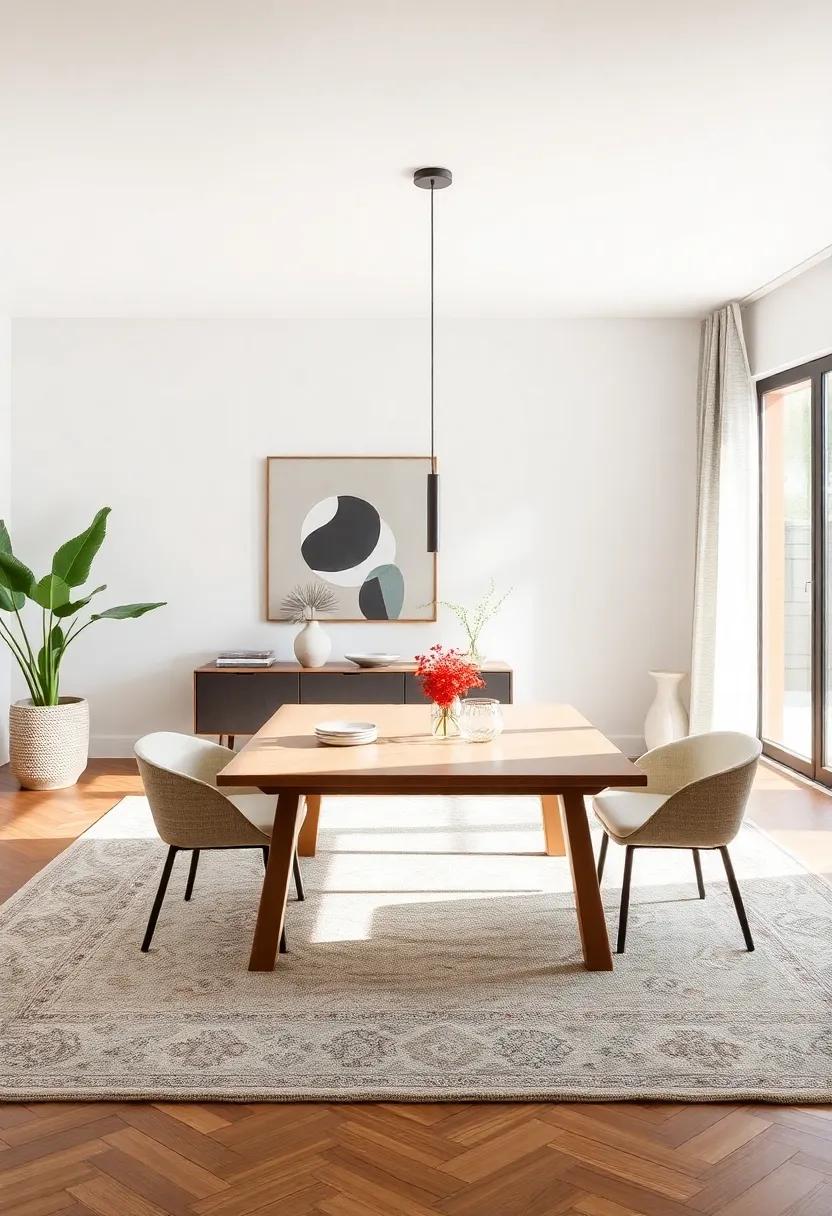
Layered rug designs can significantly enhance the ambiance of your dining area, creating a warm and inviting atmosphere for gatherings and meals. Combining various textures and patterns not only adds visual interest but also defines your dining space effectively. When selecting your rugs, consider these key elements:
- Texture: Mixing plush and flat weaves can create depth.
- Color Palette: Choose complementary colors to match your dining decor.
- Size Variation: Use different sizes to frame the dining area and add coziness.
The arrangement of your layered rugs is just as crucial as the choice of materials.Placing a larger, neutral rug underneath a smaller, colorful one can create a stunning focal point while allowing individual elements to shine. Here are some tips for arranging your rugs successfully:
- Centering: Align rugs under the table to create a cohesive look.
- Overlapping: Allow rugs to overlap slightly to enhance visual continuity.
- Functionality: ensure the rugs are durable and easy to clean for practical use.
Using Rugs To Define Spaces In Open-Concept Dining Areas

Rugs are more than just decorative elements; they serve as powerful tools for delineating spaces within open-concept dining areas. By strategically placing a rug beneath your dining table, you can create a defined space that invites conversation while also enhancing the overall aesthetic of the room. When selecting a rug, consider shape, size, and texture to complement not only your dining furniture but also the overall flow of the space. A round rug can soften angular furniture layouts,while a rectangular rug can elongate the dining area,visually pulling the space together and offering a sense of cohesion.
to maximize the impact of your rug, remember to take into account several key factors: color, pattern, and material. A bold color or a geometric pattern can create a focal point, adding personality to the dining space, while a natural fiber rug can provide warmth and comfort underfoot.To help you decide, refer to the following table that outlines ideal characteristics for different rug styles:
| Rug Type | Ideal For | Recommended Material |
|---|---|---|
| Round Rug | Small dining areas or circular tables | Cotton or Jute |
| Rectangular Rug | Long dining tables or large spaces | Wool or Synthetic blends |
| Runner Rug | Narrow spaces or as a pathway | Silk or Polyester |
Spotlighting Vintage And Antique Rugs For Timeless Dining Elegance
Incorporating vintage and antique rugs into your dining area can transform an ordinary space into a timeless sanctuary. These exquisite pieces not only serve as tasteful floor coverings but also bring a rich history and character that modern options often lack. When choosing the right rug, consider aspects such as color, pattern, and texture to harmonize with your dining décor. Look for designs that complement your dining table and chairs, enhancing the overall aesthetic without overwhelming it. The intricate craftsmanship of these rugs can also provide a beautiful contrast to contemporary furnishings, resulting in a balanced and inviting environment.
When selecting a vintage or antique rug, it’s essential to assess the size and material to ensure it meets your functional and stylistic needs. A well-placed rug can anchor your dining space effectively while offering warmth and comfort underfoot. Here are some key factors to consider:
- Size: Choose a rug that allows all chairs to sit comfortably on it when pulled out to prevent tripping hazards.
- Material: Opt for durable natural fibers like wool or cotton, which not only stand the test of time but are also easier to clean.
- Color Palette: Select a rug that aligns with your color scheme, whether it be bold and vibrant or soft and muted.
- Pattern: Traditional medallions or floral designs can add elegance, while geometric shapes introduce modernity.
For practical insights, here’s a quick comparison table featuring some popular vintage rug styles:
| Rug Style | Key Features | Best For |
|---|---|---|
| Persian | Intricate designs, durable | Traditional settings |
| Turkish | Vibrant colors, knot density | Bold accents |
| Oriental | Elegance, distinct patterns | Formal dining areas |
| Kilims | Flat-woven, contemporary flair | Casual or bohemian styles |
Personalizing Your Dining Space with Custom-Made Rugs

Choosing a custom-made rug is an excellent way to infuse your dining area with personality and flair. You can select from a variety of textures, patterns, and colors that echo your style and enhance the overall ambiance. when considering options, think about how the rug can complement existing furniture and décor. Characteristics to keep in mind include:
- Color Palette: Choose colors that harmonize with your walls and fixtures.
- Texture: Select materials that are agreeable underfoot yet sturdy enough to withstand spills and foot traffic.
- Pattern: Incorporate patterns that reflect your personality, whether it’s bold geometrical shapes or delicate floral designs.
Furthermore, custom sizing allows for a tailored fit in your dining space, ensuring the rug complements your table dimensions perfectly. Consider the shape of your dining table—round, square, or rectangular—as this will influence your rug shape selection.Below is a simple comparison of common dining table shapes and their ideal rug counterparts:
| Table Shape | recommended Rug Shape |
|---|---|
| Round | Round |
| Square | Square or Round |
| Rectangular | Rectangular |
With careful consideration of these elements, your custom rug will not only define the aesthetics of your dining area but also provide a welcoming space for family and friends.
Incorporating Cultural Influences In Rug Selections For Unique Dining Style

Infusing cultural elements into your dining space through rug selections can not only enhance its aesthetic appeal but also create an inviting atmosphere for your guests.Consider exploring rugs that celebrate different traditions, such as intricate Kilim patterns from Turkey, soft Persian designs, or vibrant Mexican textiles. Each of these options brings a unique blend of color, texture, and narrative that can complement various dining styles, be it modern, rustic, or eclectic. When choosing a rug, think about the story you want to tell and how the rug’s design can align with your table settings and decor.
In addition to patterns, materials also play a crucial role in cultural expression. Whether choosing a plush wool rug for a cozy feel or a flat-weave jute for a more casual dining experience, the texture can influence the overall ambiance. Here are some cultural influences to consider when selecting your rug:
- Moroccan Berber Rugs: Known for their geometric patterns and soft appearance.
- Indian Dhurrie Rugs: Vibrant colors and intricate designs that can add warmth.
- Scandinavian Designs: Minimalistic yet functional styles focusing on simplicity.
to help visualize your choices, consider the following table that illustrates the cultural influences, materials used, and suitable styles:
| Culture | Material | Suggested Style |
|---|---|---|
| Persian | Silk and Wool | Classic Elegance |
| Japanese | Bamboo & Cotton | Zen Minimalism |
| Native American | Wool | Earthy Bohemian |
Creating Visual Interest With Color Blocking Techniques In Dining Rugs
Incorporating color blocking techniques into your dining rug selection can transform your dining room into a striking visual masterpiece. By using vibrant hues in bold contrasts, you can create a focal point that draws the eye and sets the mood for your dining experience. Consider choosing rugs with geometric patterns or large, solid blocks of color to highlight your dining area. Pairing different shades can also add depth and dimension, making your space feel more inviting and stylish. Experiment with combinations like muted pastels alongside vibrant tones, or traditional neutrals with unexpected pops of color to achieve a balanced look.
When selecting a color-blocked rug, it’s important to match it with your existing décor. Look for complementary colors that resonate with your dining chairs, tableware, or wall colors. Here are some tips to keep in mind:
- Choose rugs with colors that echo your primary color scheme.
- Mix textures to enhance the visual interest, combining soft and hard surfaces.
- Consider the size of the rug—should it anchor the dining table or define a larger area?
To help you visualize the options,you can refer to the table below for inspiration:
| Color Combination | Ideal Style | Suggested Materials |
|---|---|---|
| Coral & Navy | Modern Elegance | Wool Blend |
| Mint Green & Beige | Coastal Chic | Jute |
| Mustard Yellow & Gray | Industrial Flair | Polypropylene |
Visualizing the Impact Of Lighting On The appearance Of Your Dining Rug

Lighting plays a crucial role in transforming the ambiance of your dining space, particularly when it comes to the appearance of your chosen rug.The interplay between light and textures can significantly enhance or diminish the visual appeal of your rug, making it essential to consider both natural and artificial lighting sources. Here are some aspects to ponder:
- Natural Light: Rugs can take on different hues and tones throughout the day based on sunlight exposure.
- Artificial Lighting: Choose fixtures that cast a warm glow to enrich the colors and textures of your rug.
- Accent Lighting: Use spotlights or floor lamps to highlight specific areas of the dining rug, creating focal points in the room.
understanding how lighting affects your rug enables you to make better choices that align with your overall aesthetic goals. Consider creating a light and dark comparison table that outlines how various rug textures respond to different types of lighting:
| Rug Texture | Natural Light | Warm Artificial Light | Cool Artificial Light |
|---|---|---|---|
| Wool | Rich,vibrant colors | Soft and cozy texture | Sharp contrasts |
| Sisal | Neutral,earthy tones | Inviting feel | Muted shadows |
| Silk | Bright,reflective quality | Luxurious shimmer | Flat,less pronounced hues |
Employing Rugs As Sound Buffers To Create A Peaceful Dining Atmosphere
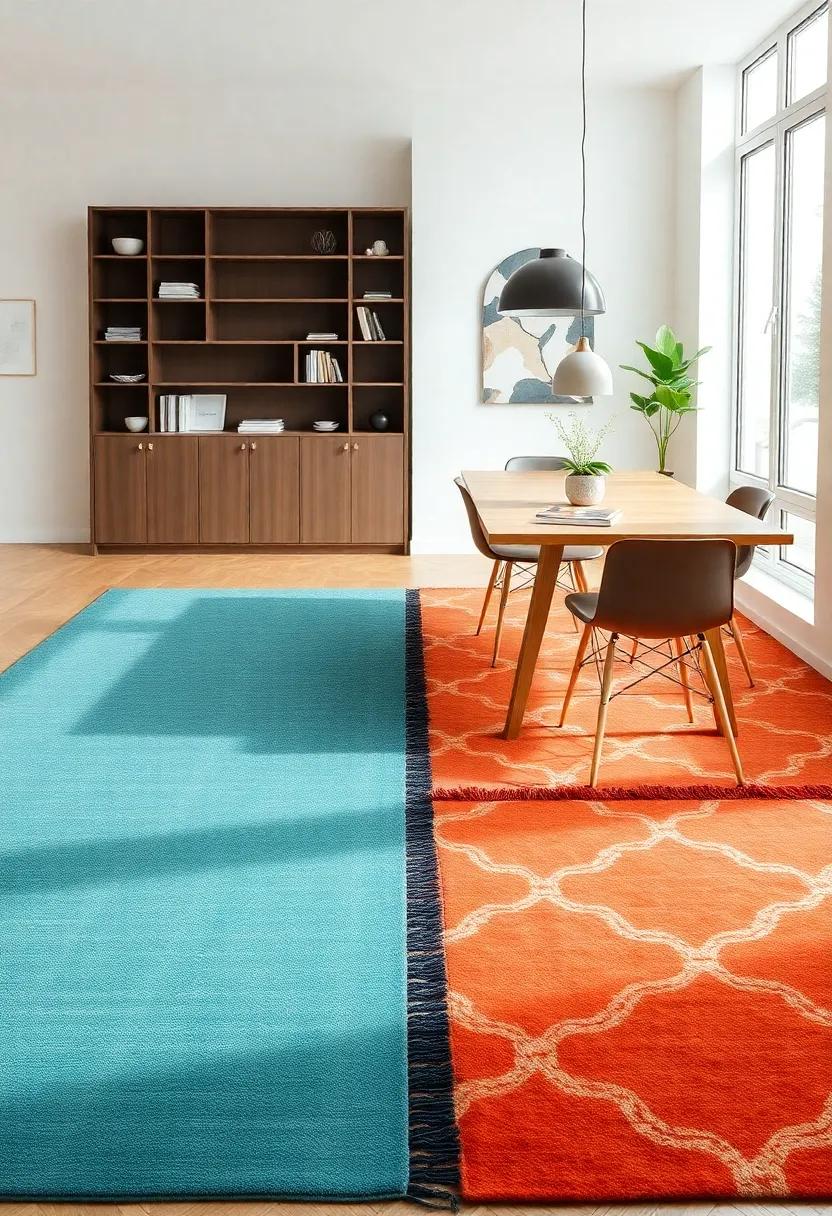
In the quest for a tranquil dining experience, the role of textiles, particularly rugs, frequently enough goes overlooked. Incorporating a well-placed rug can serve as an effective sound buffer, absorbing noise and minimizing echo. This can be particularly beneficial in spaces with hard surfaces, such as tile or hardwood flooring, which can amplify sound and make conversations difficult. To optimize this effect, consider the following features when selecting a rug:
- Material: Dense fibers, such as wool or high-pile rugs, tend to absorb sound more efficiently than flatwoven options.
- size: A larger rug can cover more surface area, creating a more significant impact on sound dampening.
- Placement: Situating the rug beneath the dining table helps to encapsulate the area, further enhancing the auditory experience.
Beyond their acoustic benefits, rugs can also enhance the overall aesthetic of your dining space. By selecting a rug that complements your decor, you can effortlessly elevate the ambiance. Here’s a helpful comparison of popular rug materials:
| Material | Sound absorption | Maintenance |
|---|---|---|
| Wool | High | Medium (requires regular vacuuming, occasional deep cleaning) |
| polyester | Medium | Low (easy to clean, stain-resistant) |
| Jute | Low | Medium (requires careful cleaning, natural fibers may wear more quickly) |
Exploring Unique Shapes Of Rugs To Introduce Playfulness To Your dining Design
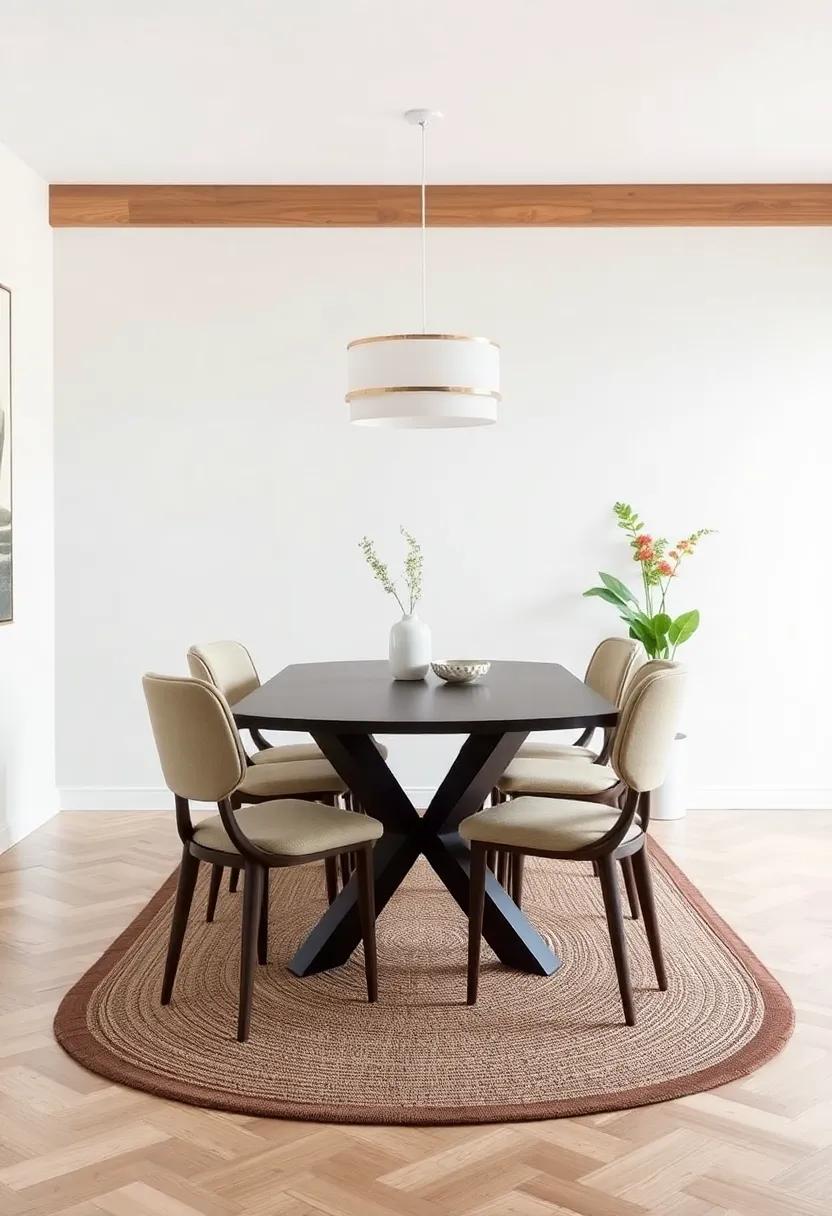
Rugs have the power to transform a dining space not just through texture and color, but by introducing distinctive shapes that evoke a sense of playfulness and creativity.Consider opting for rugs in unconventional forms such as round, hexagonal, or even asymmetrical designs that can create visual interest and enhance the dynamics of your dining area. These unique shapes can soften the lines of traditional furniture and add an unexpected twist that invites conversation around the table.
When selecting a rug shape, consider how it interacts with your existing décor. Here are some points to ponder:
- Round rugs can complement circular tables beautifully, helping to define the space and encourage a communal atmosphere.
- Rectangular rugs offer a more classic feel, particularly when paired with rectangular dining sets.
- Custom or abstract-shaped rugs can serve as artistic statements, drawing the eye and making your dining experience memorable.
To expand on your options, here’s a table showcasing potential rug shapes along with their design influences:
| Rug Shape | Best Suited For | Design Influence |
|---|---|---|
| Round | Small to medium tables | Softens angles, encourages intimacy |
| Hexagonal | Modern or eclectic styles | Offers a contemporary edge |
| Asymmetrical | Artistic or bohemian themes | Creates visual intrigue |
Key takeaways
the right rug can transform your dining space from ordinary to extraordinary, harmonizing style and comfort in perfect balance. As you embark on your journey to elevate your dining area, remember to consider not only the practical aspects—such as durability and ease of cleaning—but also the aesthetic elements that reflect your personal taste and complement your decor. From rich textures to vibrant patterns, the options are endless, and each choice tells a story. So take your time, explore different styles, and let your dining room rug be a foundation upon which cherished memories are made, one meal at a time. With these insights in hand, you’re now equipped to find that perfect piece that enhances your dining experience and ties everything together beautifully. Happy decorating!
As an Amazon Associate I earn from qualifying purchases.
 darbylanefurniture.com Interior design ideas with the latest interior inspiration
darbylanefurniture.com Interior design ideas with the latest interior inspiration
